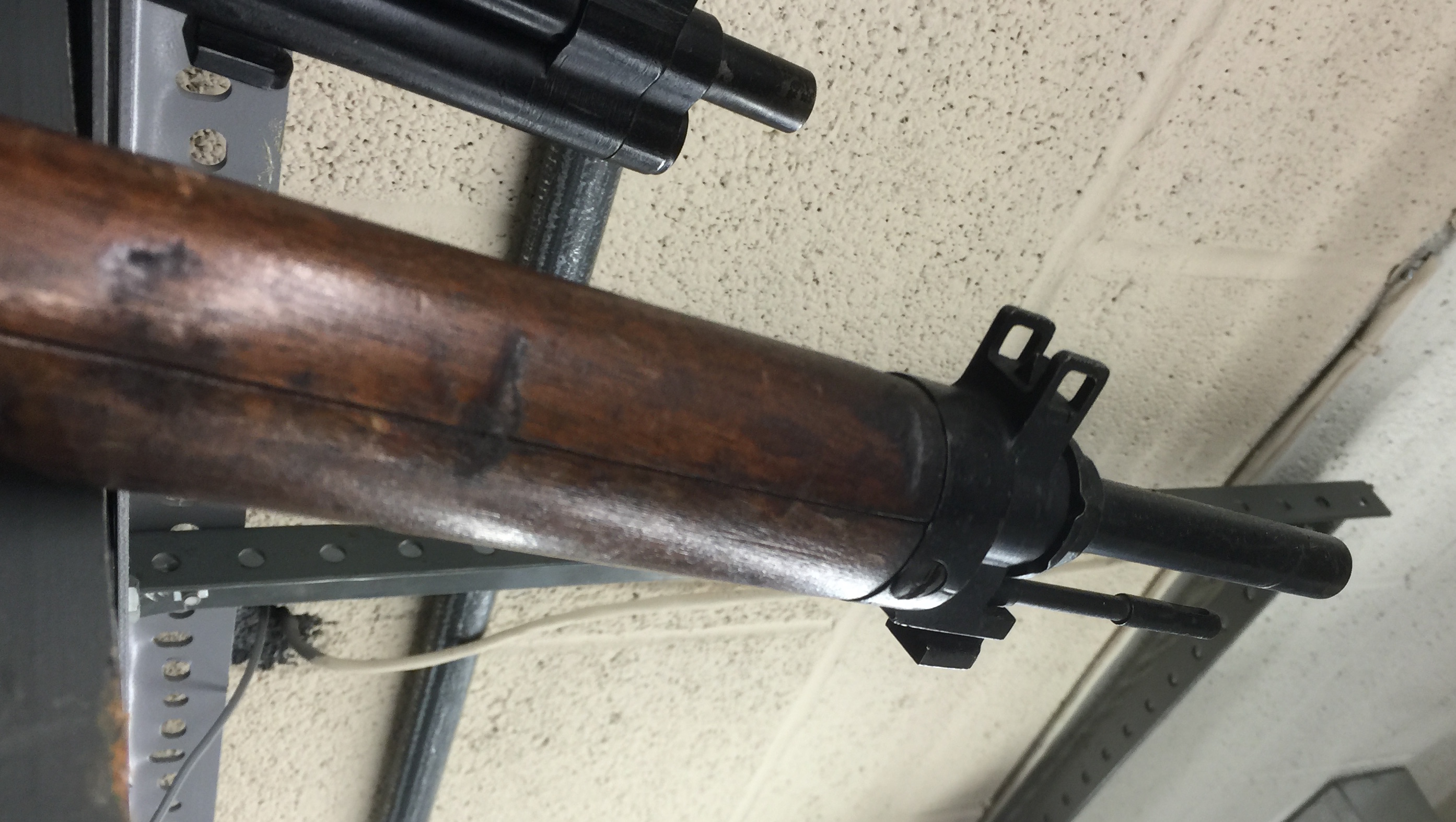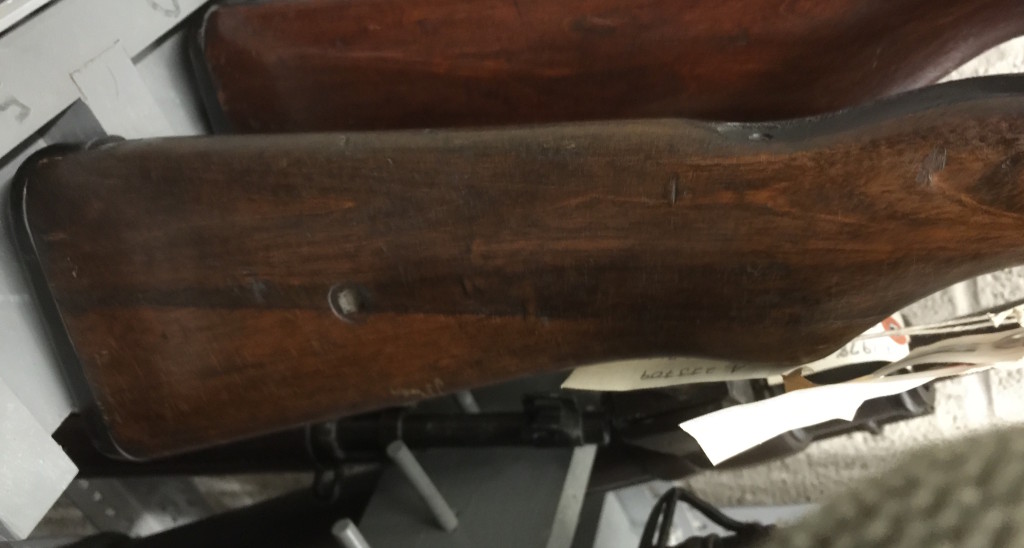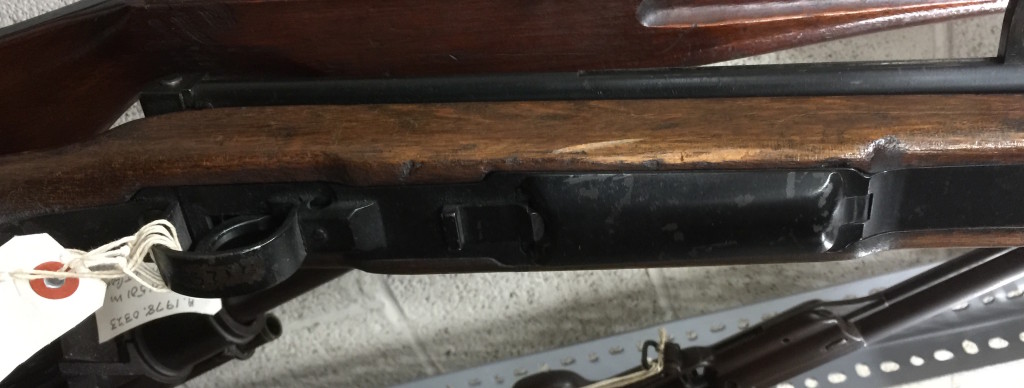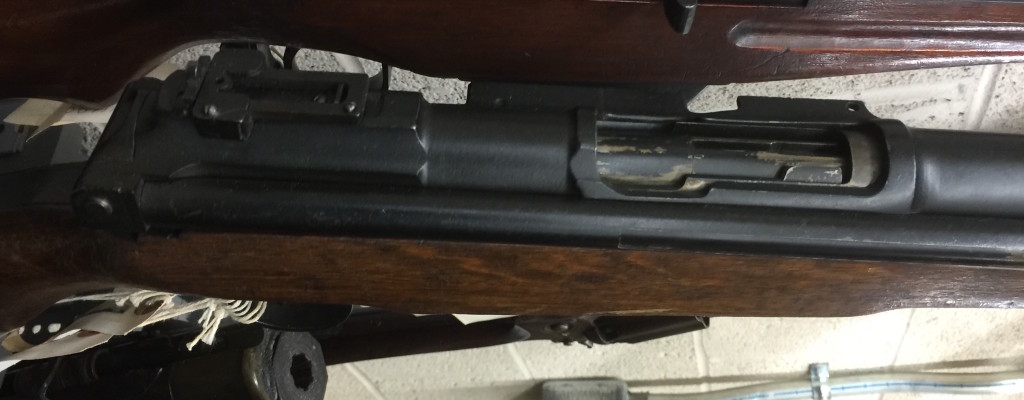Along with his two semiauto rifle prototypes, when White went to England for rifle testing he took along a work-in-progress light machine gun. The weapon was trsted by British officials, but found wanting – largely because it was really not a weapon ready for testing. The “LMG” White built was actually semiautomatic only, although it fired from an open bolt. It used what appears to be an early iteration of the gas system which was much more refined in his selfloading rifle, and it included no provision for using a bipod or tripod (an essential element of a light machine gun).
White Prototype Open-Bolt LMG at RIA
RSC 1917: France’s WW1 Semiauto Rifle at RIA
Did you know that the French Army issued more than 80,000 semiautomatic rifles during WWI? They had been experimenting with a great many semiauto designs before the war, and in 1916 finalized a design for a rotating bolt, long stroke gas piston rifle (with more than few similarities to the M1 Garand, actually) which would see field service beginning in 1917. An improved version was put into production in 1918, but too late to see any significant combat use.
The RSC 1917 was not a perfect design, but it was good enough and the only true semiauto infantry rifle fielded by anyone in significant numbers during the war.
Two VG1-5 Gustloff Last Ditch Rifles at RIA
The Volksstrumgewehr Gustloff, more commonly (albeit incorrectly) known as the VG1-5, was one of the few semiautomatic Volkssturm weapons produced at the end of WWII. I have discussed these rifles before, but wanted to take advantage of the opportunity to take a close look at two more examples of the type.
Mechanically the Gustloff uses a system quite unusual in rifles – gas delayed blowback. Chambered for the 8×33 Kurz cartridge, there are 4 small gas vent holes in the front half of the barrel which vent gas into a chamber in the front muzzle plug. Pressure in this chamber acts to keep the slide closed, thus delayed the opening of the action. A nearly identical system is used in the much later Steyr GB pistol.
One of these in particular still has its original sling, which is a neat feature (the other clearly was issued with a sling but has lost it). In total 10,000 of these were manufactured, but they were not able to make a significant impact to prolong Germany’s war effort.
H&K SL-6 and SL-7 Rifles at RIA
The German firm Heckler & Koch spent several decades building firearms all based on the same basic operating system: roller-delayed blowback (often called roller-locked, although they are not technically locked breech actions). The two best known worldwide are most likely the model 91 (aka the G3, in German Army service) and the MP-5.
However, H&K also released a sporterized version of the HK-91 in an attempt to break into different aspects of the civilian firearms market. In fact, they made two sporting version, and these today are the SL-6 and SL-7, which were more or less “paramilitary” rifles chambered for the 5.56mm and 7.62mm NATO cartridges respectively. They feature a mix of civilian and military features…on the civilian side, they have small capacity magazines (3- and 10-round), sporting-style wooden stocks, and very nice triggers. On the military side, the retain the sling attachments and iron sights of the HK-91.
Despite being relatively unknown in the US (where they were not available for very long, and also rather expensive), these H&K products are of excellent quality, and you will rarely find owners who are not very happy with them.
SIG Prototype 1924/1925 Semiauto Rifles (Video)
The Swiss SIG factory was one of the earliest producers of semiautomatic military rifles, having produced the M1908 Mondragon rifles for Mexico. They continued to experiment with self-loading rifle designs, and in the mid 1920s came up with these two examples. They are extravagantly complex, and it is quite clear why they did not become production items – but they are fascinating to examine…
Mystery Japanese Semiauto
While in the Smithsonian gun room, I noticed a semi auto Japanese rifle of a type I have not seen reference to before. It is definitely Japanese, judging from elements like the split buttstock and rear sight, and the ventilated underside of the hand guard is reminiscent of the Japanese Pedersen rifles. However, this rifle uses a rotating bolt and a receiver design that I am not familiar with.
Has anyone seen this before? The tag on it said it was a Type 5, which believe was a mix-up with the rifle next to it on the rack (which was a Type 5 Japanese copy of an M1). Click on the photos to enlarge:

Muzzle
Israeli Dror LMG: Shooting & Disassembly (Video)
The Dror was an Israeli copy of the Johnson LMG, which was made domestically in Israel as part of Israel’s war of independence in the late 1940s. The design was developed through a combination of reverse engineering a Johnson LMG (clandestinely, in a New York hotel room) and technical data leaked to the Haganah by sympathetic employees of the Johnson company. The first version was chambered in .303 British, but this was quickly replaced by an 8mm Mauser version (ammo Israel had significant stocks of at the time) using modified BAR magazines.
Unfortunately, the Dror turned out to be rather unsuccessful in testing. Hopes were very high for it, and it was put into official production before field testing was completed – only to find that it failed many tests pretty badly. Ultimately it was used for training, but saw little or no actual combat use – the Bren and MG-34 were much more successful guns.
This particular Dror is a semiauto rebuild provided by my friend Mark (thanks, Mark!).
Swiss Prototype: N33 (Video)
The N33 is one of a series of Swiss prototype semiautomatic rifles developed between WWI and WWII (the “33” refers to 1933). This particular design is interesting because it fires from an open bolt, a feature generally seen on light machine guns. An open bolt rifle typically is more difficult to shoot accurately because of the time between trigger pull and firing as the bolt travels forward to load a cartridge before firing it.
The N33 was made in several calibers, but never went into any sort of significant production.
Mondragon 1908 Semiauto Rifles – 4 Different Examples (Video)
Best known as the first semiautomatic service rifle adopted by a mainstream military force, the 1908 Mondragon was designed by Mexican native Manuel Mondragon, manufactured by SIG in Switzerland, and adopted by the Mexican Army (Ejercito Mexicano). The adoption was short lived, however, as the guns proved unreliable with the low-quality 7mm Mauser ammunition made in Mexico at the time (although they ran fine with high-quality European ammo).
After a partial delivery, Mexico refused to pay for or accept delivery of more, and this left SIG in an awkward position. They would try to sell the rifles for several year, including an attempt to market them to Germany during WWI as aviators’ rifles, with detachable magazines and brass-catching bags. No significant purchases resulted, though.
In this video I will examine 4 different examples of the Mondragon:
- A prototype 1900 model self-loader, which uses the 1908-style action but with en bloc clips instead of stripper clips
- A Mexican-issue 1908, complete with bipod and spade bayonet
- A 1908 rebarreled in 8mm Mauser and send to Germany during WWI
- A standard 1908 updated by SIG and never sold
Scotti Model X – Shooting, History, & Disassembly (Video)
The Scotti Model X (the X standing for the 10th year of the Italian Fascist era, or 1932) was one of several semiauto rifles tested by the Italian military during the late 1920s and early 1930s. The Scotti entry into these competitions was chambered for the 6.5mm Carcano cartridge and used standard 6-round clips, identical to the Carcano bolt action rifles. It also used sights basically identical to Carcano rifle sights. Where it was rather unusual was its open-bolt action, a system typically found in machine guns.
Open bolt means that when the rifle is ready to fire, the bolt is locked all the way back. Upon pulling the trigger, the bolt moves forward, picking up a cartridge, chambering it, firing it by means of a fixed firing pin, and then extracting and ejecting the spent case and locking open again, ready for another shot. This system can be used with either locked or blowback actions, and the Scotti X uses a two-lug rotating bolt to lock during firing.
In total, just about 250 Scotti Model X rifles were manufactured, and the never progressed past initial field trials. A few later models were made in very small numbers as late as 1936, but these also failed to gain any acceptance. I made some slow motion videos of this rifle a little while back, and finally took the time to do a complete video on it, including disassembly:
A Note from Rick Smith of SMG Guns
Just wanted to pass along a cool photo and note I got from Rick Smith (the guy making reproduction FG-42 rifles) this morning:
Hi All,
Can’t say how this came about past it was almost last minute and such but with permission I will say the fine folks at HMG stopped by on their way to the Shot Show yesterday. And since I have been watching all the press about what they might be coming out with and having no more knowledge up until that point than anyone else I feel compelled to share! A picture to follow – if it ever makes it from my sons phone…..
First I have to say what a nice bunch of folks that seem to have a very solid grip on a huge project. I did not get to shoot the rifle but from watching them put it together from a bag of parts and handing it to me, and then looking over the stampings and the thought behind how it all goes together I have to say Wow! Actually there is way more than that to say but it will all start coming out after shot without a doubt. I can tell you I am no stg/mp44 expert so when you tell me it is missing this crease or rib etc I will not be able to argue but what I can say is it looks awesome to me – and feels good – feels like what I think feels right. I can say our shop would have never been able to pull this off at this level – ever.
Mac knows the business of making things and where to go to get things done right and it shows. And there is no doubt in my mind after talking to him, and seeing where they are already at, as to the level of commitment to see this through. They of course will have to have time to sort through any new weapon stuff – they may already have. And these guys don’t give off any small outfit vib – this is no small time thing – looks like their intent is to build a bunch of these! Did I already mention there was more than one receiver in that bag just waiting to quickly be put together?
In closing I will say I have no other reason to post this than to share after my fortunate chance to do a hands on of their upcoming rifle. No I do not have all the info you will want – they will – we here at SMG don’t know STG’s. But once I decide on caliber I intend to own one woohoo!
Rick
SIG KE-9 & M29A Prototype Rifles (Video)
The SIG KE-9 and M29A were several in a series of developmental rifles made by SIG in Switzerland and designed by Pal Kiraly. These ultimately found no commercial or military sales, although the related KE-7 light machine gun did have some limited success.
RIA: Soviet SVT-38 Self-Loading Rifle
A lot of people think that the US was the only country in World War II to mass-issue a semiautomatic infantry rifle, but that isn’t true. While the US was the only country to issue *everyone* a semi auto, both the Soviet Union and Germany produced large numbers of them. The Soviet rifle in particular was developed over pretty much the same timeline as the M1 Garand, and literally millions of them were made and used in the war.
Today we are taking a look at the second Soviet self-loader adopted as an infantry standard, the SVT-38. The SVT was actually the runner-up up in the formal Soviet trials, and a rifle made by Simonov was actually adopted first in 1936 – but it proved too fragile in field use, and Tokarev’s rifle was brought in to replace it. The weapon was only made for a couple years before being updated to the SVT-40, and today the 1938 models are quite rare in the US.
2-Gun Match: New Inland M1 Carbine
I had a chance to get my hands on one of the new-production M1 Carbines being sold by MKS Supply under the Inland trademark. These guns have gotten a lot of press recently, and I have been interested in how they might perform. The original M1 Carbine has an interestingly mixed reputation – GIs tended to either love them or hate them.
The action on an M1 Carbine does not inspire a lot of confidence when cycled – they always sound pretty rickety. However, they are fantastically handy rifles to carry, and have virtually no felt recoil, making them great recreational guns. The question is, how will it handle a 2-gun action challenge match?
I will have a more complete review of the Inland gun in a couple weeks, along with a Rock-Ola brand reproduction from James River Armory.
James D. Julia: The Very First H&K G3 Import (3/62)
We have all seen plenty of sporter CETME rifles and civilian HK-91s, but when the G3 was new to the Germany military, there was already na interest in bringing semiauto versions into the US. The Golden State Arms Corporation was the first to do so, with three batches of imports in 1962 (just 3 years after the G3 was adopted). The first of these came into the US in March, and was basically identical to the military G3 except with a two-position semiauto-only fire control pack.
Later imports had to be made more and more distinct from the military G3s, which leaves these 3/62 guns as the closest thing to the real G3 available to the non-NFA US shooter.
Swiss SK-46 Prototype Semiauto Rifle (Video)
The SK-46 was one of several post-WWII experimental self-loading rifle designs developed for testing by the Swiss military, or for commercial export. It was manufactured by SIG at Neuhausen in both 7.5mm Swiss and 8mm Mauser. The rifle is gas operated, with a rather complex tilting bolt action. It uses 5- or 6-round detachable box magazines much like the K-31 bolt action (the magazine capacity depended on caliber; 8mm was 5 rounds and 7.5mm was 6 rounds, to match the common clips/chargers used in each caliber).
One interesting element of the design was the use of a charging handle made to mimic the appearance and function of a traditional bolt action rifle. A similar approach can be seen on the German MP-35 submachine gun and G-41(M) rifle. The SK-46 also incorporated a standard rail for attaching a 2.2x optical sight (not present on this rifle).
RIA: Japanese Type 4 Garand Copy
Partway through 1944, the Japanese Imperial Navy began a program to provide their infantry units with better firepower than was afforded by the bolt action Arisaka rifles. The initial experimentation was based on rechambering captured US M1 Garand rifles for the 7.7 Japanese cartridge, but an incompatibility of American en bloc clips with the Japanese cartridge hamstrung the project. In response, the M1 was reverse engineered, and the Yokosuka Naval Arsenal began to manufacture a copy of the rifle which would use a 10-round fixed magazine fed by two standard stripper clips.
This rifle was designated the Type 4 (2604/1944), although it is often referred to today as the Type 5. In total, parts for 200 rifles were manufactured, but only about 125 had been actually assembled into functional guns by the time the war ended.
RIA: Bendix-Hyde Second Model Prototype Carbine
In late 1940, the US military opened a competition for what would become the M1 Carbine – a rifle that needed to use the .30 Carbine cartridge and weigh no more than 5 pounds (2.27kg). No fewer than 9 companies and designers entered the first round of competition in April 1941, including John Garand, Val Browning, Eugene Reising, Auto-Ordnance, and George Hyde. Hyde’s entry was one of the best performers, and just a few changes to it were requested.
A second round of trials was held in September 1941, and this is one of the 5 Hyde carbines made for that second test. Unfortunately for Hyde, while he had made the changes requested, he had also managed to make the gun less accurate, less reliable, and more difficult to disassemble than his first version. Winchester would ultimately win the competition, with a rifle designed in an amazing 34 days.
RIA: T3E2 Trials .276-Caliber Garand
By 1932, the competition for the new US emiautomatic service rifle had been narrowed down to just two designs: John Pedersen’s delayed blowback toggle action and John Garand’s gas-operated action. Both rifles were chambered for Pedersen’s .276 caliber cartridge, and used 10-round en bloc clips. Twenty samples of each were made and sent out to infantry and cavalry units for field testing.
This rifle is one of those Garands – serial number 15, to be specific. The results of the trial was a preference for the Garand rifle, and the testing board got as far as writing a formal recommendation for its adoption before General MacArthur vetoed the whole .276 caliber idea for economic and logistical reasons (the US Army had a whole lot of .30-06 ammo and not a lot of spare cash). The result was ultimately a .30 caliber Garand rifle becoming the M1, but this T3E2 trials rifle in .276 sure is a sweet-handling piece of machinery!
RIA: Japanese Trials Gas-Operated Pedersen Rifle
The Japanese semiauto rifle trials of the early 1930s had a total of four entrants – Kijiro Nambu and his company, Tokyo Gas & Electric, the Tokyo Army Arsenal, and Nippon Special Steel. This rifle is one of the third iteration of the design from Nippon Special Steel. It is a design based originally on the Pedersen, but with substantial changes. It is a toggle-locked and gas-operated action with a gas piston that moves forward upon firing. It feeds from a ten-round detachable box magazine, which is unfortunately missing on this example.
In total, 13 of these rifles were made for trials, with 4 of them actually being tested (and firing over 100,000 rounds between them without any extraction problems, apparently). This rifle did have some accuracy problems, though, which would be fixed by its designer for the fourth and final trials, at which point it and the Tokyo Army Arsenal rifle were determined to be of equal quality – and then the whole program was dropped as the Marco Polo Bridge incident caused the Sino-Japanese War to quickly intensify.




